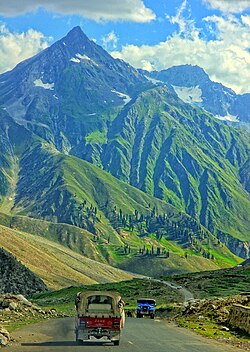Khyber Pakhtunkhwa
province of Pakistan From Wikipedia, the free encyclopedia
Remove ads
Khyber Pakhtunkhwa is a province in northwest Pakistan. The capital is Peshawar[1] and it has a population of over 40 million people[2] and an area of 28,773 mi² or (74,521 km²). The province was created in 1901 during British rule when it was separated from Punjab province of the British India Empire.[3] A referendum was held in the North West Frontier Province on 2 July 1947. The majority of voters wanted to join with Pakistan, with only a very small number voting to join with India. The province became a part of Pakistan, because of this referendum.[4]
Khyber Pakhtunkhwa is divided into 29 districts.[5]
Remove ads
Names of Khyber Pakhtunkhwa

In 1901 it was created as a province of British India and was known as the North-West Frontier Province, it kept this name for over a hundred years, but over time many people wanted the name to change. One of the names people wanted to use was Afghania ,[6][7] that name was first suggested by the founding leaders of the Muslim League in 1933.[7]
However when Pakistan became independent in 1947 Khyber Pakhtunkhwa kept the old name, it was still known as North-West Frontier Province and not Afghania. Finally in 2010 the government renamed "North-West Frontier Province" to "Khyber Pakhtunkhwa".
Just like Punjab is named after the Punjabi people Khyber Pakhtunkhwa is named after the Pakhtun people, lately there has been a demand to change the name "Khyber Pakhtunkhwa" to just "Pakhtunkhwa" by a Pakhtun party [9] but some non-Pakhtun people in the province would not be happy with the name change.[10]

Remove ads
Geography
Khyber Pakhtunkhwa is mainly located on the Iranian plateau and forms the point where the slopes of the Hindu Kush mountains on the Eurasian plate become the Indus-watered hills approaching South-central Asia. Because these two plates are pushing against each other it has led to earthquakes taking place.[11] The famous Khyber Pass links the province to Afghanistan, the town of Landi Kotal (which is at the western end of the Khyber Pass) is 5km from the Afghan border. While the Kohala Bridge at the other end of the province in Abbottabad District is a major crossing point over the Jhelum River in the east.
The province has an area of 28,773 mi² or (74,521 km²) — similar in size to New England in North America.[12] Peshawar, Mardan, Kohat, Abbottabad, Dera Ismail Khan and Hangu are the main cities.
The land varies from dry rocky areas in the south to forests and green plains in the north. The climate can be extreme with intensely hot summers to freezing cold winters. Despite these extremes in weather, agriculture remains important and viable in the area.
The hilly terrain of Kalam, Upper Dir, Swat, Naran and Kaghan is renowned for its beauty and attracts a great many tourists from neighboring regions and from around the world. Swat is popular among tourists as the "Switzerland of South Asia" as there are many landscape similarities between it and the mountainous terrain of Switzerland.
Geographically the province could be divided into two zones:
The northern zone is cold and snowy in winters with heavy rainfall and pleasant summers with the exception of Peshawar basin, which is hot in summer and cold in winter. It has moderate rainfall. The southern zone is arid with hot summers and relatively cold winters and scanty rainfall. The northern zone extends from the mountains of the Hindu Kush to the borders of Peshawar basin while the southern zone extends from Peshawar to the Derajat basin.
The major rivers that cross through the province are the Kabul, Swat, Chitral, Kunar, Siran, Panjgora, Bara, Kurram, Dor, Haroo, Gomal and Zhob.
Remove ads
People of Khyber Pakhtunkhwa
According to the 1998 census, the population of the province was approximately 20 million,[13] of whom 52% are males and 48% are females, the density of population is 187 people per km².
Languages
In KPK about 70% of the people are Pashtuns and they speak Pashto as a first language. Other widely spoken languages are Kalami, Chitrali, Kohistani, and Yidgha. Panjabi is understood by majority of the people.
Government
The President of Pakistan appoints a Governor as head of the provincial government of Khyber Pakhtunkhwa. There is a directly-elected Provincial Assembly, which has 124 elected members (including 22 seats reserved for women and 3 seats for non-Muslims). The Provincial Assembly elects a Chief Minister to act as the chief executive of the province, assisted by a cabinet of ministers.
Remove ads
Related pages
References
Wikiwand - on
Seamless Wikipedia browsing. On steroids.
Remove ads











